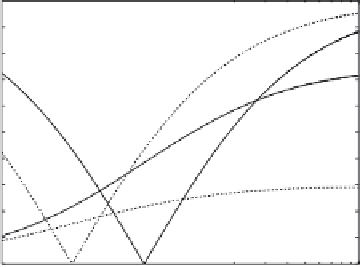Geoscience Reference
In-Depth Information
1
0.9
R
AA
0.8
0.7
0.6
0.5
R
SA
0.4
0.3
0.2
0.1
0
0.1
1
10
Σ
P
(Ohm)
1
Fig. 7.9.
Non-meridional propagation. Coecients
R
AA
and
R
SA
for the inclined
magnetic field
B
0
versus the Pedersen conductivity
Σ
P
. The Hall conductivity
Σ
H
=
Σ
P
. Dashed lines and solid lines correspond to inclination
I
=20
◦
and
I
=60
◦
,
respectively. The other parameters are
k
x
=0
.
01 km
−
1
,k
y
=0
.
001 km
−
1
,f
=
2
π/
100 Hz
,σ
g
=0
.
1Ohm
−
1
,c
A
= 1100 km/s
,h
= 100 km
The steep decreasing of
R
AA
(
Σ
P
) takes place if
Σ
P
tends to
Σ
P
=
Σ
A
sin
I
(see (7.129)). Here the Alfven wave is not reflected from the ionosphere
[15]. It follows from Fig. 7.9 that
R
AA
≈
0
.
63 Ohm
−
1
for
I
=60
◦
.
The same value of
Σ
P
follows from (7.129). Transition from the large
Σ
P
0 when
Σ
P
=
Σ
P
≈
Σ
P
to the small
Σ
P
Σ
P
leads to the change of
R
AA
from 1 by day
1 by night and to the phase change of the reflected wave at the point
Σ
P
from0to180
◦
. Direction of the magnetic vector of the reflected wave changes
to the opposite one when going from day (
Σ
P
>Σ
P
)tonight(
Σ
P
<Σ
P
)con-
ditions. The total horizontal magnetic field
b
τ
at the ionosphere then changes
from
to
−
2
b
(
i
)
A
b
(
i
)
A
. It means that the dayside ionosphere is simi-
lar to a perfect conductor and the nightside ionosphere to a dielectric for the
Alfven wave. Figure 7.9 also points out the important fact that the zero point
for the reflection coecient
R
AA
disappears in the low-latitudes because of
Σ
P
decreasing.
At
Σ
P
>Σ
P
,
the
b
τ
transformation coecient
R
SA
of the incident Alfven
wave into the reflected FMS-wave tends to
R
SA
∝
|
b
τ
|≈
to
|
b
τ
|
sin
I
and at
Σ
P
<Σ
P
the
dependence of
R
SA
on inclination
I
weakens. This result can be found from the
analysis of the approximate formula (7.142) for the reflection coecient. For
simplicity, let us consider the case of quasi-meridional propagation
|
k
y
||
k
x
|
.
b
(
i
)
/
√
ε
m
, and the
The electric field of the incident Alfven wave is
E
(
i
)
=
−
=
R
AA
b
(
i
)
/
√
ε
m
. Then, the total
electric field of the reflected wave
is
E
(
r
)
R
AA
)
b
(
i
)
/
√
ε
m
. Substituting the approximate reflection
electric field is
≈−
(1
−
coecient
R
(0)
AA
from (7.142), we have the electric field of the Alfven wave:
2
|
sin
I
|
b
(
i
A
,
E
A
≈−
(7.150)
X







Search WWH ::

Custom Search